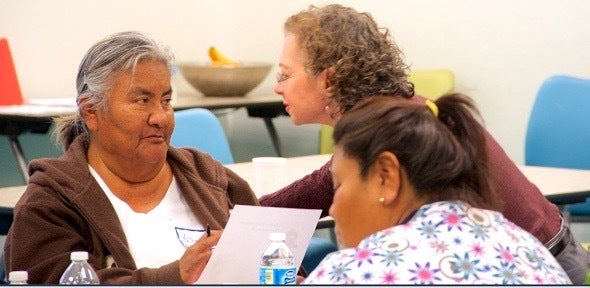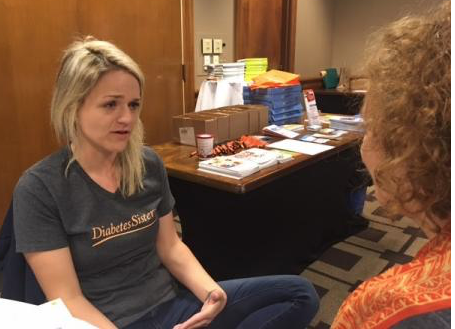Trust me when I say I’m grateful for, and excited by, each technological advance and innovation that makes living with diabetes easier, and makes me a better custodian of my care. For cloud-connected glucose meters and continuous glucose monitors, smart insulin pumps, the coming closed loop hybrid system and the ten or so companies in Silicon Valley racing toward delivering an artificial pancreas.
But our reverence for diabetes devices and technology, the “Hardware,” has caused us to forget an equally essential component for diabetes self management – the “Heartware.”

Author with patient and provider of Pascua Yaqui tribe
People are more successful managing diabetes, or any chronic condition, when they have both “Hardware” and “Heartware.”
What is heartware and why haven’t you heard of it?
Heartware is the human connection between health professional and patient. It’s the act of seeing the person with illness, not merely the illness. It’s the dialogues that explore a patient’s strengths, skills, resources and challenges. It is listening wholeheartedly, being open to where there’s pain, providing a healing touch and being fully present. These are our instincts as human beings yet they are not encouraged in medicine.
But these small, immeasurable acts of seeing each other foster trust, safety, confidence and aliveness. They cause people to engage, move forward and take their care into their own hands. Heartware also fortifies us to try and to use hardware more sustainably. Unfortunately, in our pull toward diabetes equipment we have turned away from this ally.
Professor Jane Dutton at the University of Michigan says high quality connections - those that make people feel valued - foster flourishing. High quality connections stimulate the uplift you feel when someone expresses genuine concern for how you are doing. High quality connections Dutton says have us think more clearly and act more competently.
We know this instinctively, yet many health professionals turn away. Danielle Ofri, MD, PhD, author and NY Times columnist, says empathy gets trained out of medical students in their third year of medical school due to too many demands, poor modeling of doctor-patient behavior and taxing efficiency demands.
Novo Nordisk’s DAWN2 (Diabetes Attitude Wishes and Needs) study findings reveal significant disconnects between patients and providers:
- Providers don’t accurately access their own ability to communicate or provide support. Their perceptions about their care far exceeds those of patients.
- Providers report that they provide a high level of practical or communicative support. Yet only slightly more than half (average 57%) of PWDs (people with diabetes) feel supported by their healthcare team.
We know when providers express empathy their, and their patients’, outcomes improve. Peer-mentoring also improves patients’ management and clinical outcomes, and, with the lowest-tech device imaginable -- another human being to listen, engage and connect with.
So why is heartware overlooked?
I can easily think of three reasons:
1) Low awareness. Communication skills and empathy are not stressed in medical school. Immediate Past President of the American Association of Clinical Endocrinologists, Dr. George Grunberger, told me doctors often think in terms of adding a new drug to a patient’s therapy to improve their care. There’s little appreciation that the first principle of a good physician is understanding that a patient is telling his/her story and we just need to listen.
2) Poor skills. While nurses and diabetes educators are trained in heartware-related skills, physicians are not. In the absence of such skills, most focus on the pathology of the disease, not the person. And unfortunately, even those trained in caring, are often overburdened and without tools. Time and again when I conduct a workshop and have health professionals do a simple listening exercise they are startled how two minutes of listening and being listened to, without interruption, brings them closer to their partner. They are hungry for more.
3) Our health care system’s infrastructure doesn’t reward heartware. Time is short, boxes need to be checked, electronic record keeping is king and one does what one gets paid for.
Three weeks ago I facilitated a leadership workshop for DiabetesSisters Leadership Institute. I taught 26 young women how to listen, how to discover strengths and skills in their patient group members and the transformative quality of presence. I skilled them in heartware. They came away transformed with greater empathy and compassion, and as more effective leaders.

Listening Exercise
I emphasize “hardware” and “heartware” when I speak to health professionals. I cite it as part of the Flourishing Treatment Approach I’m sharing - a way to work with people with diabetes from a relationship-centered, strengths-based, positive framework. It resonates across cultures and continents because in our hearts we recognize its wisdom.
You haven’t heard of heartware because, unlike amputations, it’s not covered by health insurance. Because we have no evidence-based studies to prove its value. Because doctors seldom ask their patients what’s important to them. Because it seems easier and less risky to create a new app than train people in the psycho-social squishy stuff.
Innovation beyond technology
So while I’m helped by seeing my blood sugar numbers in real time, being able to analyze my patterns and share my data with my endo and my husband. While I long for non invasive technologies. While I respect activity trackers and gamification, I’ll never forget how I felt once when checking my blood sugar. I got a reading of 54 mg/dl (2.9 mmol/l) on my meter and immediately my phone rang. Picking it up, my meter company’s coach said to me, “I saw your number, do you need help?”
I have closed many presentations with this quote from Dr. Rachel Naomi Remen. Remen is the founder of The Healer’s Art and she has lived with Crohn's disease for sixty years. “Our expertise is not the only tool we have to strengthen our patients’ will. Many times my expertise has been far less critical to the eventual outcome for my patient, than my presence and my caring.”
When we think of innovation we almost exclusively think of hardware. Yet support groups, mandatory school, free university, our legal system, community food gardens, libraries, remote learning, telehealth, home gyms, pedestrian malls and bike lanes in New York City, are all innovations. Now we need to be innovating the patient/provider relationship, how our time is used together, and apart, and our treatment approach.
I’m reading more and more companies have a Chief Technology and Innovation Officer. It’s time for a Chief Compassion and Connection Officer. Hardware and heartware, both, are the engines of chronic care.